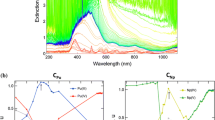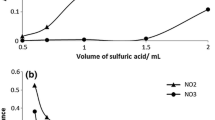Abstract
In this study, a Partial Least-Squares (PLS) regression approach mainly based on a lab-produced calibration set enhanced with a few process samples is proposed. Comparison with spectrophotometric reference offline measurements and predictions by PLS is presented on a validation set composed of real process solutions. The mean difference between the presented model predictions and offline measurements is less than 5%. The results show that this approach can be effective for process control and can successfully replace usual sample preparations and time-consuming calibration procedures if the model is constructed properly.







Similar content being viewed by others
References
Ache HJ (1992) Analytical chemistry in nuclear technology. Fresenius J Anal Chem. https://doi.org/10.1007/BF00328573
Nelson GL (2019) On-line monitoring of solutions within microfluidic chips: simultaneous Raman and UV-vis absorption spectroscopies. ACS Sens. https://doi.org/10.1021/acssensors.9b00736
Cerdà V (2019) Automation of radiochemical analysis by flow techniques – A review. Trends Anal Chem. https://doi.org/10.1016/j.trac.2019.06.001
Cleveland JM (1979) The Chemistry of Plutonium. American Nuclear Society, La Grange Park, Illinois
Patrick Carey W (1991) Determining chemical characteristics of plutonium solutions using visible spectrometry and multivariate chemometric methods. Chemom Intell Lab Syst. https://doi.org/10.1016/0169-7439(91)80055-U
Moody KJ, Shaughnessy DA, Casteleyn KC, Ottmar H, Lützenkirchen K, Wallenius M, Wiss T (2010) In: Morss LR The chemistry of the actinide and transactinide elements, 4th edn. Springer, New York
Lines AM (2017) Multivariate analysis for quantification of plutonium(IV) in nitric acid based on absorption spectra. Anal Chem. https://doi.org/10.1021/acs.analchem.7b02161
Lascola R (2017) A piecewise local partial least squares (PLS) methods for quantitative analysis of plutonium nitrate solutions. Appl Spectrosc. https://doi.org/10.1177/0003702817734000
Casella A (2016) MicroRaman measurements for nuclear fuel reprocessing applications. Procedia Chem. https://doi.org/10.1016/j.proche.2016.10.065
Kirsanov D (2017) UV-Vis spectroscopy with chemometric data treatment: an option for on-line control in nuclear industry. J Radioanal Nucl Chem. https://doi.org/10.1007/s10967-017-5252-8
Tse P (2020) Review of on-line and near real-time spectroscopic monitoring of processes relevant to nuclear material management. Anal Chim Acta. https://doi.org/10.1016/j.aca.2020.02.008
Bro R (2003) Multivariate calibration What is in chemometrics for the analytical chemist? Anal Chim Acta. https://doi.org/10.1016/S0003-2670(03)00681-0
Naes T, Isaksson T, Fearn T, Davies T (2002) A User-Friendly Guide to Multivariate Calibration and Classification. NIR Publications, Chichester
Day RS (1989) A Visible/Near-IR Spectral Database for Plutonium Solutions of Known Nitric Acid, Fluoride, and Oxalate Composition. Report LA—11480, Las Alamos National Laboratory
Patrick Carey W (1989) Spectrophotometric method for the analysis of plutonium and nitric acid using partial least-squares regression. Anal Chem. https://doi.org/10.1021/ac00190a016
Geladi P (1986) Partial Least-Squares regression: a tutorial. Anal Chim Acta. https://doi.org/10.1016/0003-2670(86)80028-9
Faber NM (2002) Standard error of prediction for multiway PLS1 Background and a simulation study. Chemom Intell Lab. https://doi.org/10.1016/S0169-7439(01)00204-0
Ryan JL (1960) Species involved in the anion-exchange absorption of quadrivalent actinide nitrates. J Phys Chem. https://doi.org/10.1021/j100839a007
Lee MH (2007) Absorption spectroscopic properties for Pu (III, IV and VI) in nitric and hydrochloric acid media. J Radioanal Nucl Chem. https://doi.org/10.1007/s10967-007-6848-1
Balasubramonian S (2020) Thermodynamic modeling of Pu(IV) and nitric acid extraction by 1.1 M tri-iso-amyl phosphate in n-dodecane. J Radioanal Nucl Chem. https://doi.org/10.1007/s10967-020-07338-8
Kubic Jr WL (2012) A thermodynamic model of plutonium(IV) nitrate solutions. J Radioanal Nucl Chem. https://doi.org/10.1007/s10967-012-1703-4
Kirk Veirs D (1994) Characterization of the nitrate complexes of Pu(IV) using absorption spectroscopy, 15N NMR, and EXAFS. J Alloy Compd. https://doi.org/10.1016/0925-8388(94)90924-5
Barr ME (2002) Plutonium(IV) sorption by soluble anion-exchange polymers. Sep Sci Technol. https://doi.org/10.1081/SS-120002241
Kvalheim OM (2014) Variable importance in latent variable regression models. J Chemom. https://doi.org/10.1002/cem.2626
Estienne F (2004) A comparison of multivariate calibration techniques applied to experimental NIR data sets. Part III: Robustness against instrumental perturbation conditions. Chemom Intell Lab. https://doi.org/10.1016/j.chemolab.2004.04.007
Sooväli L (2006) Uncertainty sources in UV-Vis spectrophotometric measurement Accredit. Qual Assur. https://doi.org/10.1007/s00769-006-0124-x
Wise BM (1996) The process chemometrics approach to process monitoring and fault detection. J Process Control. https://doi.org/10.1016/0959-1524(96)00009-1
Berg JM (1998) Plutonium(IV) mononitrate and dinitrate complex formation in acid solutions as a function of ionic strength. J Radioanal Nucl Chem. https://doi.org/10.1007/BF02385932
Savitzky A (1964) Smoothing and differentiation of data by simplified least squares procedures. Anal Chem. https://doi.org/10.1021/ac60214a047
Lines AM (2020) Sensor Fusion: Comprehensive real-time, on-line monitoring for process control via visible, near-infrared, and raman spectroscopy. ACS Sens. https://doi.org/10.1021/acssensors.0c00659
Author information
Authors and Affiliations
Corresponding author
Ethics declarations
Conflict of interest
The authors declare no competing financial interest.
Additional information
Publisher's Note
Springer Nature remains neutral with regard to jurisdictional claims in published maps and institutional affiliations.
Rights and permissions
About this article
Cite this article
Bailly, G., Maloubier, D. & Legay, G. Plutonium(IV) quantification in acidic process solutions using partial least-squares regression applied to UV–Vis spectrophotometry. J Radioanal Nucl Chem 331, 1267–1273 (2022). https://doi.org/10.1007/s10967-022-08205-4
Received:
Accepted:
Published:
Issue Date:
DOI: https://doi.org/10.1007/s10967-022-08205-4




